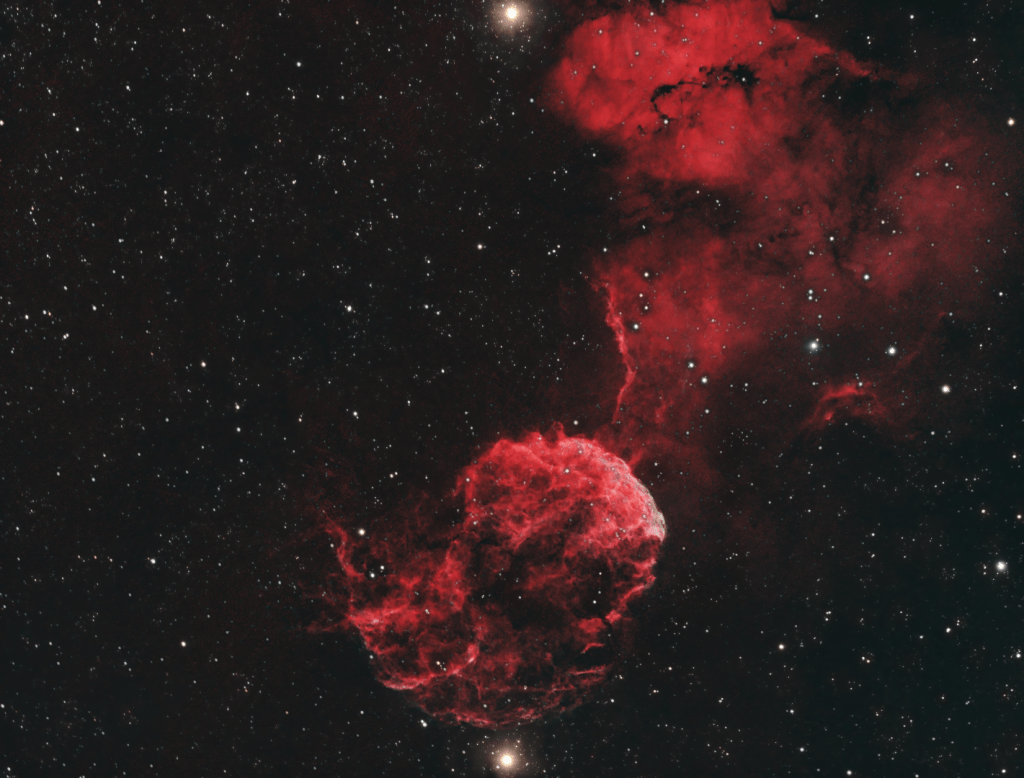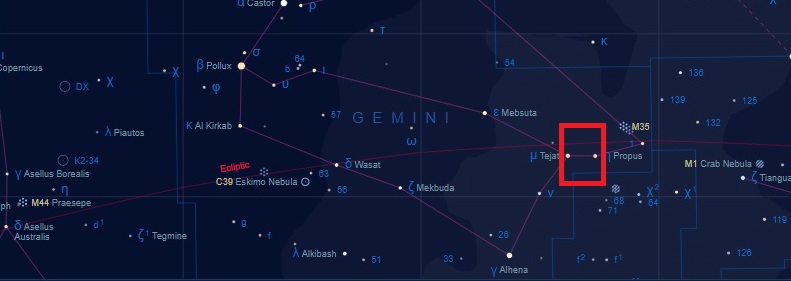
Here at Fairvale Observatory, most of the exciting deep sky objects associated with the transit of the Milky Way during winter have disappeared over the western horizon by early spring. Notwithstanding, a brief period of decent conditions at the very end of March provided a late window of opportunity to image a core area of our galaxy, which being viewed above Oirion at a higher declination in the constellation of Gemini, helped to extend the limited imaging time available. Frankly after such a terrible period of weather since last November, I was desperate to get one last image from this rich part of the night sky and try out my new Chroma narrowband filters again, which thankfully worked out well after imaging IC443 the Jellyfish Nebula over four nights, despite there being less than two hours of suitable viewing and darkness each night.
The remnant of a supernova that occurred between 3,000 and 33,000 years ago, located in the Gemini constellation the Jellyfish Nebula is some 5,000 light years from Earth. With a diameter of 70 light-years, the angular view of the nebula is some 50 arcminutes or nearly twice the size of a full moon. Overall the nebula consists of at least three distinct shells reflecting the complex nature of this Type-II supernova, which is interacting with the surrounding area of molecular clouds.

Acknowledging the limited time available – compounded by lingering cloud each night – I chose to image The Jellyfish in narrowband bicolour, hoping to collect some SII photons on another day to add to the Ha & OIII. At the end I also added some short LRGB subs to improve the final star colours and during processing used Ha as a false luminance layer to help bring out the complex structure of the nebula further. The image has been deliberately framed by the adjacent large stars Propus (bottom) and Tejat (top), which caused plenty of problems during processing but in my opinion form an essential component when imaging this object. Whilst IC443 is undoubtedly the main act, it is set off well by the large adjacent area of detailed nebulosity and the smaller reflection nebula IC444 to the right which is easy to overlook. Despite many issues I am very pleased with the final image that beautifully shows off this spectacular DSO and the surrounding region in all its glory, which seems all the better being something of a last chance opportunity that I thought I’d missed for this season.
| IMAGING DETAILS | |
| Object | IC443 Jellyfish Nebula & IC444 |
| Constellation | Gemini |
| Distance | 5,000 light-years |
| Size | 50 arc minutes ~70 light years |
| Apparent Magnitude | +12 |
| Scope | William Optics GT81 + Focal Reducer FL 382mm f4.72 |
| Mount | SW AZ-EQ6 GT + EQASCOM computer control & Cartes du Ciel |
| Guiding | William Optics 50mm guide scope |
| + Starlight Xpress Lodestar X2 camera & PHD2 guiding | |
| Camera | ZWO1600MM-Cool mono CMOS sensor |
| FOV 2.65o x 2.0o Resolution 2.05”/pix Max. image size 4,656 x 3,520 pix | |
| EFW | ZWOx8 EFW & 31mm Chroma LRGB + 3nm Ha &OIII filters |
| Capture & Processing | Astro Photography Tool + PHD2 + Deep Sky Stacker, PixInsight v1.8.8-7, Photoshop CS3, +Starnet, Topaz Denoise |
| Image Location & Orientation | Centre RA 06:18:53.542 DEC +22:31:13.827 @21.30h Right = North |
| Exposures | NB 15 x 600 sec Ha , 12 x 600 sec OIII & BB 15 x L, 11 x R, 9 x G5, 11 x B x 120 sec Total integration time: 6hr 02 min |
| @ 139 Gain 21 Offset @ -20oC | |
| Calibration | NB 5 x 600 sec Darks + 15 x Ha & OIII flats & dark flats BB 10 x 120 sec Darks + 15 LRGB Flats & Dark Flats @ ADU 25,000 |
| Location & Darkness | Fairvale Observatory – Redhill – Surrey – UK Typically Bortle 5-6 |
| Date & Time | 29th & 30th March + 4th & 5th April 2021 @ +21.00h |
| Weather | Approx. <5oC RH >=30% 🌙 99% waning |
